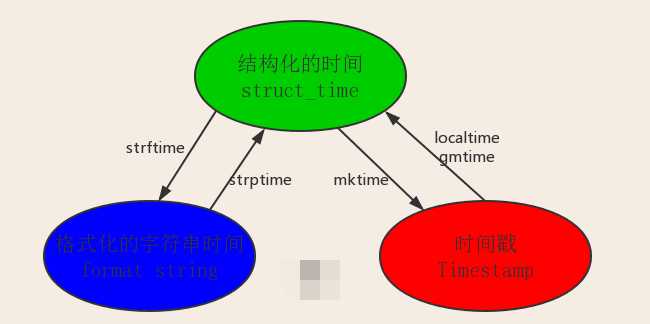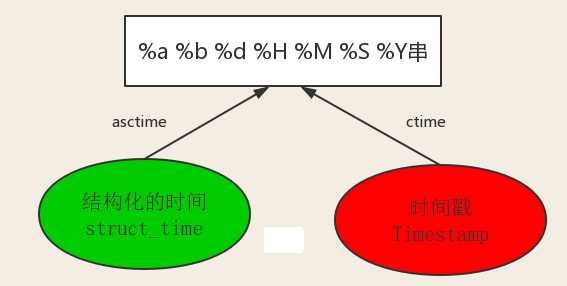标签:重命名 key == img code 运算 exist ogr 3.x
表示时间我们通常用三种形式:
import time print(time.time()) #时间戳:1498025310.887425 print(time.strftime("%Y-%m-%d %X")) #格式化的时间字符串:2017-06-21 14:08:30 print(time.localtime()) #本地时区的struct_time print(time.gmtime()) #UTC时区的struct_time 结果: 1498025310.887425 2017-06-21 14:08:30 time.struct_time(tm_year=2017, tm_mon=6, tm_mday=21, tm_hour=14, tm_min=8, tm_sec=30, tm_wday=2, tm_yday=172, tm_isdst=0) time.struct_time(tm_year=2017, tm_mon=6, tm_mday=21, tm_hour=6, tm_min=8, tm_sec=30, tm_wday=2, tm_yday=172, tm_isdst=0)
三者的转换关系:

计算机认识的时间只能是‘时间戳‘格式,而程序员可处理的或者说人类能看懂的时间有: ‘格式化的时间字符串‘,‘结构化的时间‘。
import time print(time.time()) print(time.localtime()) #将结构化的时间转换为格式化的字符串时间 print(time.strftime("%Y-%m-%d %X", time.localtime())) #将结构化的时间转换为时间戳 print(time.mktime(time.localtime())) #将时间戳转换为结构化的时间 print(time.localtime(1498025310)) #将格式化的字符串时间转换为结构化的时间 print(time.strptime("2017-06-21 16:55:36", "%Y-%m-%d %X")) 结果: 1498035729.0793116 time.struct_time(tm_year=2017, tm_mon=6, tm_mday=21, tm_hour=17, tm_min=2, tm_sec=9, tm_wday=2, tm_yday=172, tm_isdst=0) 2017-06-21 17:02:09 1498035729.0 time.struct_time(tm_year=2017, tm_mon=6, tm_mday=21, tm_hour=14, tm_min=8, tm_sec=30, tm_wday=2, tm_yday=172, tm_isdst=0) time.struct_time(tm_year=2017, tm_mon=6, tm_mday=21, tm_hour=16, tm_min=55, tm_sec=36, tm_wday=2, tm_yday=172, tm_isdst=-1)

#将结构化的时间转换为字符串时间 print(time.asctime(time.localtime())) print(time.asctime()) #如果没有参数,将会将time.localtime()作为参数传入。 print(‘我是分割线---------------‘) #将时间戳转换为字符串时间 print(time.ctime(time.time())) print(time.ctime()) #如果没有参数,将会将time.time()作为参数传入。 结果: Wed Jun 21 22:19:16 2017 Wed Jun 21 22:19:16 2017 我是分割线--------------- Wed Jun 21 22:19:16 2017 Wed Jun 21 22:19:16 2017
import random print(random.random()) #(0,1)----float 大于0且小于1之间的小数 结果:0.3869734571949781 print(random.randint(1,3)) #[1,3] 大于等于1且小于等于3之间的整数 结果:3 print(random.randrange(1,3)) #[1,3) 大于等于1且小于3之间的整数 结果:1 print(random.choice([1,‘abc‘,[‘a‘,23,‘world‘]])) #1或者‘abc‘或者[‘a‘,23,‘world‘] 结果:[‘a‘, 23, ‘world‘] print(random.sample([1,‘abc‘,[‘a‘,23,‘world‘]],2)) #列表元素任意2个组合 结果:[[‘a‘, 23, ‘world‘], ‘abc‘] print(random.uniform(1,3)) #大于1小于3的小数 结果:2.164429956472153 l = [1,2,4,5,9] random.shuffle(l) print(l) #打乱l的顺序,相当于"洗牌"[5, 2, 9, 4, 1]
生成随机验证码实例:
import random def verify_code(): res = "" for i in range(5): res1 = random.randint(1,9) res2 = chr(random.randint(97,122)) res3 = chr(random.randint(65,90)) res4 = random.choice([str(res1),res2,res3]) res +=res4 return res print(verify_code()) 结果: IcglH
os模块是与操作系统交互的一个接口
需要掌握的应用:
os.getcwd() 获取当前工作目录,即当前python脚本工作的目录路径 os.chdir("dirname") 改变当前脚本工作目录;相当于shell下cd os.makedirs(‘dirname1/dirname2‘) 可生成多层递归目录 os.removedirs(‘dirname1‘) 若目录为空,则删除,并递归到上一级目录,如若也为空,则删除,依此类推 os.mkdir(‘dirname‘) 生成单级目录;相当于shell中mkdir dirname os.rmdir(‘dirname‘) 删除单级空目录,若目录不为空则无法删除,报错;相当于shell中rmdir dirname os.listdir(‘dirname‘) 列出指定目录下的所有文件和子目录,包括隐藏文件,并以列表方式打印 os.remove() 删除一个文件 os.rename("oldname","newname") 重命名文件/目录 os.stat(‘path/filename‘) 获取文件/目录信息 os.path.abspath(path) 返回path规范化的绝对路径 os.path.dirname(path) 返回path的目录。其实就是os.path.split(path)的第一个元素 os.path.basename(path) 返回path最后的文件名。如何path以/或\结尾,那么就会返回空值。即os.path.split(path)的第二个元素 os.path.exists(path) 如果path存在,返回True;如果path不存在,返回False os.path.join(path1[, path2[, ...]]) 将多个路径组合后返回,第一个绝对路径之前的参数将被忽略 os.path.getatime(path) 返回path所指向的文件或者目录的最后存取时间 os.path.getmtime(path) 返回path所指向的文件或者目录的最后修改时间
os.path.getctime(path) 回path所指向的文件或者目录的创建时间 os.path.getsize(path) 返回path的大小
选择性掌握的应用:
os.path.split(path) 将path分割成目录和文件名二元组返回
os.path.isabs(path) 如果path是绝对路径,返回True
os.path.isfile(path) 如果path是一个存在的文件,返回True。否则返回False
os.path.isdir(path) 如果path是一个存在的目录,则返回True。否则返回False
示例:
import os print(os.getcwd()) os.chdir(r‘C:\Users\Administrator\PycharmProjects\untitled4‘) print(os.getcwd()) print(‘我是分割线--------‘) print(os.listdir(r‘C:\Users\Administrator\PycharmProjects\untitled4\a‘)) print(‘我是分割线--------‘) res = os.stat(r‘C:\Users\Administrator\PycharmProjects\untitled4\a\b\c\d‘) print(res) print(res.st_ctime) print(‘我是分割线--------‘) dirname,basename=os.path.split(r‘C:\Users\Administrator\PycharmProjects\untitled4\a\a.txt‘) print(dirname) print(basename) print(‘我是分割线--------‘) s1=r‘C:\Users\Administrator\PycharmProjects\untitled4\a\b\c‘ s2=r‘c.txt‘ res=os.path.join(s1,s2) print(res) 结果: C:\Users\Administrator\PycharmProjects\untitled C:\Users\Administrator\PycharmProjects\untitled4 我是分割线-------- [‘a.txt‘, ‘b‘] 我是分割线-------- os.stat_result(st_mode=16895, st_ino=7881299347966345, st_dev=1221946964, st_nlink=1, st_uid=0, st_gid=0, st_size=0, st_atime=1498052199, st_mtime=1498052199, st_ctime=1498052199) 1498052199.7336605 我是分割线-------- C:\Users\Administrator\PycharmProjects\untitled4\a a.txt 我是分割线-------- C:\Users\Administrator\PycharmProjects\untitled4\a\b\c\c.txt
hash:一种算法 ,3.x里代替了md5模块和sha模块,主要提供 SHA1, SHA224, SHA256, SHA384, SHA512 ,MD5 算法
三个特点:
1.内容相同则hash运算结果相同,内容稍微改变则hash值则变
2.不可逆推
3.相同算法:无论校验多长的数据,得到的哈希值长度固定。
import hashlib m=hashlib.md5()# m=hashlib.sha256() m.update(‘hello‘.encode(‘utf8‘)) print(m.hexdigest()) #5d41402abc4b2a76b9719d911017c592 m.update(‘alvin‘.encode(‘utf8‘)) print(m.hexdigest()) #92a7e713c30abbb0319fa07da2a5c4af m2=hashlib.md5() m2.update(‘helloalvin‘.encode(‘utf8‘)) print(m2.hexdigest()) #92a7e713c30abbb0319fa07da2a5c4af ‘‘‘ 注意:把一段很长的数据update多次,与一次update这段长数据,得到的结果一样 但是update多次为校验大文件提供了可能。 ‘‘‘
以上加密算法虽然依然非常厉害,但时候存在缺陷,即:通过撞库可以反解。所以,有必要对加密算法中添加自定义key再来做加密。
import hashlib # ######## 256 ######## hash = hashlib.sha256(‘898oaFs09f‘.encode(‘utf8‘)) hash.update(‘alvin‘.encode(‘utf8‘)) print (hash.hexdigest())#e79e68f070cdedcfe63eaf1a2e92c83b4cfb1b5c6bc452d214c1b7e77cdfd1c7
实例:模拟撞库破解密码
import hashlib passwds=[ ‘alex3714‘, ‘alex1313‘, ‘alex94139413‘, ‘alex123456‘, ‘123456alex‘, ‘a123lex‘, ] def make_passwd_dic(passwds): dic={} for passwd in passwds: m=hashlib.md5() m.update(passwd.encode(‘utf-8‘)) dic[passwd]=m.hexdigest() return dic def break_code(cryptograph,passwd_dic): for k,v in passwd_dic.items(): if v == cryptograph: print(‘密码是===>\033[46m%s\033[0m‘ %k) cryptograph=‘aee949757a2e698417463d47acac93df‘ break_code(cryptograph,make_passwd_dic(passwds)) 模拟撞库破解密码
python 还有一个 hmac 模块,它内部对我们创建 key 和 内容 进行进一步的处理然后再加密:
1 import hmac 2 h = hmac.new(‘alvin‘.encode(‘utf8‘)) 3 h.update(‘hello‘.encode(‘utf8‘)) 4 print (h.hexdigest())#320df9832eab4c038b6c1d7ed73a5940
Python--模块之time、random、os、hashlib
标签:重命名 key == img code 运算 exist ogr 3.x
原文地址:http://www.cnblogs.com/metianzing/p/7060716.html